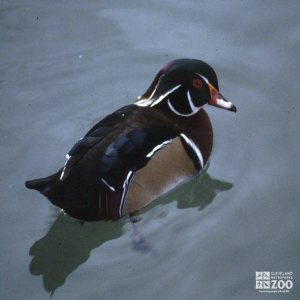North American Wood Duck
[Aix sponsa]

Wood ducks are 17 to 20 inches in length and weigh 1.1 to 1.9 pounds, with an average weight of 1.5 pounds. Males have a crested head, that is mostly iridescent green on the crown and sides, and a white throat stripe. The breast is maroon with white spotting. The upper wing surface is mostly iridescent with a blue and green sheen. The eyes are red, and the legs and feet yellow. The bill is brightly patterned with black, white and red. Females are mostly olive brown. The head is grayish on the sides and greenish black on the crown with a large white eye ring. The eyes are brown and the bill black.
Location: Animals Formerly at Zoo
Share:
Range
The range of the wood duck is from British Columbia to California, Nova Scotia to Minnesota to Florida and Texas and Cuba.
Habitat
The wood duck inhabits forest-edged lakes, ponds, swamps and marshes; and freshwater marshes in late summer and fall.
Conservation Status
Least ConcernPrimary Threats
Gestation
28 to 37 days (average 30 days)
Litter
13 to 15 eggs
Behavior
Wood ducks are highly social only during migration and when wintering. At this time roosting sites can range from a few hundred to several thousand individuals. When they arrive at their breeding grounds, they are already paired and are found in groups of no more than a dozen birds. Nesting depends on available sites. They will nest in tree holes and will accept nest boxes. Raccoons and gray squirrels will destroy the eggs, and snapping turtles are a danger to the ducklings. When foraging on the water, wood ducks often tip up and can gather materials from water as deep as 18 inches. They rarely dive for food.
Reproduction
The wood duck female is responsible for choosing the nest cavity, preferably high in a tree with an entrance too small for raccoons. Cavities over water are preferred. Only the female incubates, and the male leaves the female after the fourth week of incubation. When the ducklings are only 24 hours old, they will leap into space, often dropping 30 to 50 feet to the ground or water at their mother's call. The mother leaves the young at about 7 weeks.
Wild Diet
Acorns, hickory nuts, beechnuts, vegetative parts of aquatic plants
Zoo Diet
Waterfowl breeder pellets and generic grain
